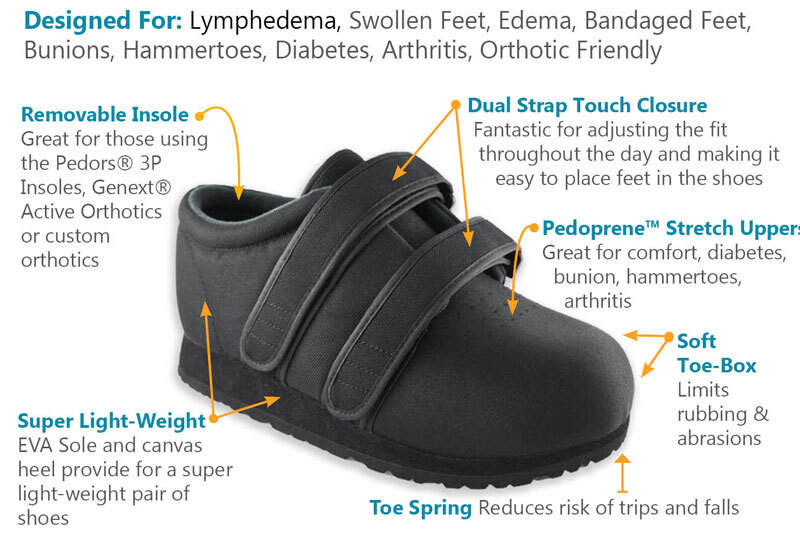Lymphedema Shoes - A Guide
Lymphedema Shoes: A Guide To Fitting For Lymphedema
Finding appropriate lymphedema shoes requires an evaluation as to how swollen your feet are. Although there may be different causes for lymphedema in your feet, and various degrees of severity, the commonality is that the foot is much bigger than normal and requires shoes with much more room than a normal shoe. There are three key measurements - the girth, the width and of course the length of your feet. This guide will tell you how to take those measurements and review other features to consider before choosing the perfect shoes for your lymphedema.

By Stephen O'Hare, President and Co-Founder, Pedors Shoes
For over 25 years Pedors Shoes has designed and manufactured shoes for problem feet. Our goal is to get our customers back on their feet again with affordable, quality footwear that addresses their specific needs. We’re here to help. Your footwear problems are our challenges.
What Is The Difference Between Edema And Lymphedema?
Edema and lymphedema are related conditions where fluid accumulates in the body’s tissues but they different in their causes and characteristics.
• Edema is a general term for the accumulation of fluid in the areas between cells or in tissues called the interstitial spaces. Lymphedema is a specific type of edema that results from a malfunction or blockage in the lymphatic system that drains waste fluids and waste products from tissues.
• Edema can be caused by heart failure, kidney disease, liver disease or by injury, inflammation or infection. Lymphedema is a chronic condition and can be congenital or hereditary or as a result of damage or disruption to the lymphati system afer surgery, radiation thereapy or infection.
• Edema can affect any part of the body and can affect one side or both. Edema can be sudden or long lasting. Lymphedema most typically affects the extremities like arms and legs where the swelling is often pitted and can be associated skin changes and a risk of infection.
In summary the choice of treatment and management depends on identifying the specific type and cause of fluid retention.
The Magnificent 7 Design Features To Consider When Looking For Lymphedema Shoes
1. The shoe has to open up: Because of the accumulation of lymphatic fluid on the top of the foot and often limited ability to articulate the ankle, it is difficult to stuff the foot inside a shoe that deson’t open up. In order to easily place the foot of the foot bed the shoe needs to open up.
2. Velcro closures are preferred over lace ups as it’s easier to open the shoe up each time the shoe is put on the foot. Also easier to adjust over the course of the day as the swelling increases.
3. Compression in a shoe: Therapeutic uppers that incorporate materials that provide support as well as some compression to keep the swelling down.
4. Lightweight: If the shoe is too heavy for the person wearing it that may have a limited range of motion it will increase the likelihood of a fall as well as making it less likely that the shoe will be worn. An often overlooked fact is that shoes provide protection for the foot and reduce the risk of injury or infection.
5. Machine washable: For people living with lymphedema a machine washable shoe helps keep the shoe clean.
6. Indoor / outdoor soling: For lymphedema, It’s a good idea to put your shoes on first thing in the morning and keep them on all day. So the shoe needs to be designed so that it can be worn inside the house and also outside the house. So lightweight soling that offers some traction is preferred.
7. Multiple sizes and widths: It’s all about the accommodation and fit.

How To Measure Your Shoe Size For Lymphedema
For the best results, if possible, it’s helpful to have someone help you to take the measurements needed to determine the size of your foot. You will need some paper, a pen or marker and a tailor’s tape or a piece of string and a tape measure. Most importantly, if you plan to wear wraps, bandages or compressionwear inside the shoe, take the measurements with the garments on the foot.
• Length: Trace each foot on a piece of paper: Ideally in a standing weight bearing position, make a tracing of each foot ensuring that the pen or marker is held vertically. From the tracing,measure the longest length from the longest toe to the back of the heel to the nearest 1/8th of an inch.
• Width: From the tracing measure the widest part of the foot which is usually at the ball of the foot or metatarsal heads again to the nearest 1/8th of an inch.
• Girth: Using the tailor’s tape or a piece of string, measure the circumference of the foot where the swelling is most - usually around the arch or instep of the foot. Place the start of the tape on the middle of the top of the foot. Wrap the tape under the foot and pull it up to the top of the foot to where it joins the start of the tape. If you use a piece of string, mark the string where it joins the start with your pen or marker and measure the length on a tape measure- again to the nearest 1/8th of an inch.
• Go to: the Pedors Sizing Guide and start by determining your shoe length on the length chart.Then go to the width chart and find your length on the left hand side of the chart and then see which width column your width falls under. Finally with your length and width, check to see if that particular size has enough volume inside the shoe to accommodate your girth measurement.
Lymphedema Pro-Tip: For mild or moderate lymphedema where the lymphedema is somewhat under control usually a 4E width works best. In most instances the 6E width is required for the majority of people living with lymphedema. In really severe instances or if wraps or bandages are being worn inside the shoe, the 10E width works best.
Who Are The Medical Professionals That Specialize In Treating Lymphedema?
Lymphedema requires specialized care from healthcare professionals that focus on diagnosis, management and treatment.
• Certified Lymphedema Therapist (CLT) Certified lymphedema therapists are highly trained professionals who specialize in the treatment of lymphedema. They are often physical or occupational therapists who have received specialized training in lymphatic drainage, compression therapy and other techniques to manage lymphedema.
• Certified Lymphedema Specialist ( CLS) Some healthcare professionals, such as nurses or physical therapists pursue additional certification to become lymphedema specialists with expertise in the assessment and management of lymphedema.
• A lymphologist is a medical doctor who specializes in the treatment of lymphatic disorders including lymphedema. They have advanced training in lymphatic system function and lymphedema management. The Academy of Lymphatic Studies has a directory of therapists.
If the lymphedema is severe and requires surgical intervention such as a lymphaticovenous anastomosis (LVA) or a lymph node transfer The Society for Vascular Surgery can offer some guidance
• The American Society of Clinical Oncology is a strong resource for information on surgical oncology and radiation oncology and the management of lymphedema in cancer patients is a common side-effect of cancer treatment.
• Certified Wound Specialists have expertise in managing wounds and compplications associated with lymphedema including skin breakdown and ulcers. The Wound, Ostomy and Continence Nurses Association has a directory of nurses near you.
Where Can I Go To Be Fitted With Shoes For Lymphedema?
In most instances, shoes for lymphedema need to be wide and deep enough to accommodate the lymphatic fluid that accumulates on the dorsum or top of the foot. The most common mistake that is made when trying to find a shoe big enough is to go longer instead of wider. The problem with that approach is that the shoe ends up being too long for the foot and increases the risk of tripping. Think of it as walking around all day in a clown’s shoe. The answer is to go wider.
The challenge for retail shoe stores is that the vast majority of their customers only need a Medium width shoe. Some shoe stores will have some shoes in a Wide width. Very few will have an Extra wide width shoe. At a minimum, for people living with lymphedema they need a shoe that is at least Extra extra wide or 4E in width. More than likely they will need an Extra, extra, extra wide shoe or 6E width. If compression wraps or bandages are worn inside the shoe or the lymphedema is really severe, then a 10E width shoe may be required.
www.letswalk.com is a directory of foot healthcare professionals who are familiar with the challenges of fitting patients with lymphedema and, by appointment, can size and special order from the shoe manufacturers that make shoes for lymphedema that they work with.
If there is not a local provider near you, some shoe manufacturers will work directly with the consumer offering guidance on sizing and offer free returns and exchanges to ensure a proper fit without the additional cost of paying for extra shipping fees.
Supporting Pages
Pedors Womens Lymphedema Shoes Buyers Guide
Pedors Mens Lymphedma Shoes Buyers Guide
Womens Product Section For Shoes For Lymphedema
Mens Product Section For Shoes For Lymphedema
Questions For Pedors?
We'd love to hear from you! Call 800 750 6729 Monday through Friday, 8:30 am - 5:00 pm EST or use email us at support@pedors.com.




